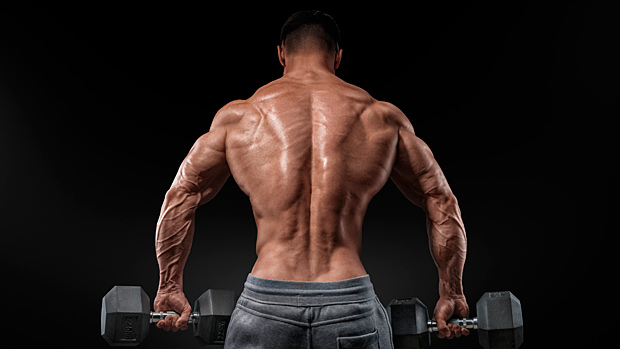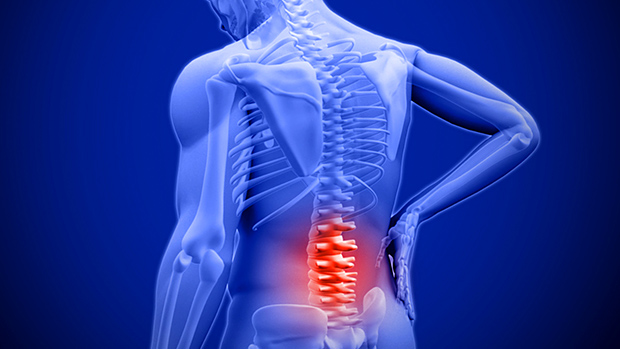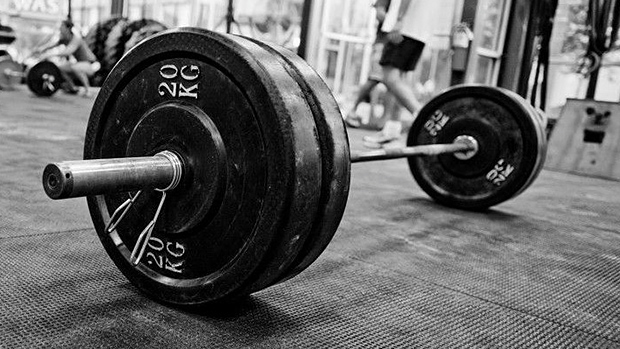Posterior Chain: Top to Bottom
Before lifters learned the term "posterior chain" they used to just say they were doing "back work." It was what strength athletes did to create balance and stability for the competitive lifts. They did rows, lat pulldowns, work for the spinal erectors and rear delts, etc. All good stuff.
But simply throwing in rows, pulldowns, and face-pulls won't cut it. When you look at the kinetic chain and the muscles that help stabilize each part of it, you should know what each of those muscle groups do and how to strengthen them for maximum stability.
Hypertrophy and mobility are also important. A smaller or weaker muscle is less stable than a larger and stronger one. A lot of people think they lack mobility because they can't hold a certain position throughout the full range of motion. The truth? They simply aren't strong enough. So let's start at the calves and work our way up.
Most people don't put enough effort into calf training. They say, "You're either born with big calves or not. It's all genetics." Yes, calves are stubborn. But so is your girlfriend, and you haven't given up on her yet.
It's not your muscle belly length or insertion points. It's that you don't know how to train your calves in a way that'll get them to respond. The calves play a part in helping the hamstrings with knee flexion. The lesser-known muscles of the deep flexor group also work to maintain the medial arch and prevent pronation of the ankle which (along with a weak glute medius) can contribute to "knee cave" or valgus collapse.
When that happens, the hips and glutes play a smaller role in the squat, and adductors end up taking the brunt of the tension to perform the movement. Ideally, you'd get all of those muscle groups involved. That way the load is distributed throughout a larger area and adequate tension distribution is achieved. But if the ankles over-pronate or if they come off the floor, then a tight Achilles tendon and inflexible calves are usually part of the problem. So you need to increase flexibility in the calves, strengthen them, and get them to grow.
What to Do
Use the standing calf raise. Oh, you tried that already? Probably not the right way. For starters, the Achilles tendon is the thickest tendon in the body and is built for dynamic/explosive movement. So when you get on a standing calf raise machine and bounce up and down, the Achilles has no problem performing that work, taking most of the tension off the calves. In order to shift that work to the calves, you need to remove as much of the stretch reflex as possible and focus on maximally lengthening and shortening the muscles.
8-Second Reps for Calves
- Hold the stretch position (bottom) for 5 seconds on every rep.
- Then hold the contracted position (top) for 3 seconds on every rep.
- Lower slowly and repeat.
Try 4 sets of 12 reps, rotating through different calf exercises each time you work them. Do this at least twice a week.
If you've been a bouncing all this time, then be prepared to actually feel your calves working for the first time ever. Also be prepared for a tremendous amount of soreness. The extended time in the stretch position will also help take care of a tight Achilles.
Most people only do two movements for the hammies: leg curls and stiff-legged deadlifts. While this is a great combination, it's limiting. It only trains them in the sagittal plane. That may be okay for someone who's only focused on aesthetics, but if we're talking about performance and building stabilization then the hams should be worked in the transverse plane.
The hamstrings bend and stabilize the knee, among other things. They also play a major role in reducing and controlling force and the deceleration of a movement. They're predominantly fast twitch, and thus respond very positively to eccentric-based training (negatives). In fact, a lack of eccentric strength in the hams is the main culprit for hamstring injuries, not just the strength imbalance between them and the quads.
The factors that need to be addressed here are knee flexion in the sagittal plane with full hip extension, and the transverse plane to address deceleration strength and stability. Both require an emphasis on the eccentric.
What to Do
Don't allow your hips to come up off the bench. It negates a complete shortening of the hamstrings. To distribute the greatest amount of tension directly onto the hamstrings, you must have hip extension into the leg curl pad so that the hams can reach a fully contracted state in the top position. So push your hips as hard as possible into the pad to make sure this is happening.
Alternating Eccentric Leg Curl with Hip Extension
An easy way to increase the eccentric loading (without having to get someone to push down on the leg curl during the negative part of the rep), is to do the concentric or lifting part of the rep with both legs, then the lowering part with one leg. After you hit failure with the single-leg eccentrics, continue the set by using both legs and a controlled negative.
Alternate legs on each rep. Make sure to do the eccentric portion in a controlled fashion to take advantage of the overloading effect. Don't just let your leg freefall when lowering the weight. Do 4 sets of 8 reps.
Another Option
For hamstrings, also do "10 and 2" stationary lunges. You can put a barbell on your back for these, but start with bodyweight at first. If you're weak moving through this range of motion then you could end up straining any one of the muscle groups involved.
10 and 2 Stationary Lunge
Pretend you're standing on a clock. Step with your left leg to the 10 o'clock position and perform a controlled eccentric and powerful concentric on each rep. Then with the right leg, step to 2 o'clock and do the same. Do 4 sets of 10 reps for each leg.
The glutes are made up of the gluteus maximus, medius, and minimus. All three perform a function in stabilizing the hip and pelvis. The gluteus max is mainly responsible for hip extension. The medius and minimus are responsible for hip abduction, which also helps with stabilization at the knee and ankle. The glute max's primary function involves movement of the hip, while the glute medius and minimus work together to help stabilize the hip.
What to Do
Since the hamstrings work with the gluteus maximus for hip extension, it's important to choose a movement where they perform synergistically to create balance. The banded good morning does the job.
Why not use a bar? First, it's easy to do wrong. You see guys load the bar with back-breaking weights, then barely bend over and squat down slightly. This sucks because the hamstrings don't lengthen enough in this position, and hip flexion is minimal.
Second, with a barbell the resistance is high at the bottom quarter of the movement and minimal at the top quarter. Ideally you'd want the resistance to increase as the concentric is performed so that tension doesn't diminish as much during the completion of hip extension. Banded good mornings fix the problem.
Banded Good Morning
You can put bands around the end of the bar, but I like to attach one to the rack so that it's providing resistance at the waist during the movement. It also acts as a cue to "get your hips through."
Keep your knees barely bent during this movement, and use a controlled eccentric and a somewhat powerful concentric for each rep. You need to think about pushing your butt out and into the wall behind you while maintaining this "soft knee" position.
Hold the top portion of the movement for a second before starting the next rep. You shouldn't look like you're dry humping the band. Do 4 sets of 12 reps.
These muscles help abduct the hip and act as a stabilizer for the pelvis, allowing the glute max to perform the dynamic portions of a movement, like when you're doing something on one leg. And don't say you're not into unilateral work. Otherwise you'd never walk, sprint, or lunge.
Because the glute medius is responsible for hip abduction, it needs to be strong in order to hold proper knee tracking during the squat. So if your ankle flexibility isn't the cause of your valgus collapse, your glute medius likely isn't strong enough to hold proper knee position. This will get it stronger.
Split Squat with Isometric Holds
Perform a split squat, rear leg on a bench behind you, then only come about 3/4ths of the way up. Hold that position for 3 seconds before lowering again. You can use a dumbbell or bodyweight only. That all depends on your level of strength/development. However, I'd recommend using progressive overload and working your way up to using the heaviest dumbbell you can while maintaining great form. Do 3 sets of 8 reps with a 3 second isometric hold.
While the erectors can get thicker and stronger through isometric contractions in movements that are hip dominant, to make them as strong as possible they also need additional work.
What to Do
Ideally you'd perform back raises on equipment that supports the abs so that you can roll the spine over it safely in the eccentric portion of the movement, before performing the concentric phase.
Remember, this isn't a hyperextension where the spine stays in a neutral position with the erectors working isometrically. They already do that on most hip-dominant movements. So we want to take the hips out and make the erectors work through an eccentric and concentric range of motion.
Back Raise
Allow your lower back to round slightly, then go into the concentric phase up to the point where you're back into a neutral spine position. Don't hyperextend the spine. Do 3 sets of 10-12 reps once a week using light weight. Sound too easy? Well, this area already gets an enormous amount of isometric work during other exercises, so don't overdo it.
A weak lower trapezius can be the culprit for many issues related to pain or poor movement. The lower traps aid in lifting and stabilizing the shoulder through its entire 180 degrees of flexion.
But scapular depression is required to initiate and activate the traps, and lifters tend to do more exercises that emphasis scapular retraction. Low bar squatting? Retract the scaps. Bench pressing? Retract the scaps. Rowing? Retract the scaps. Then we sit all day in a hunched position allowing the lower traps to become stretched and weak. Bad combination.
We become too internally rotated from bench pressing, which leads to shoulder pain. We're short and tight in the upper traps, and long and weak in the lower traps, which causes instability in the shoulder joint, potentially leading to impingement and improper overhead pressing. If the lower traps can't isometrically hold position in things like the deadlift or squat, then our maximal loads will be lower.
Weak lower traps mean that the upper traps will hog most of the work. Plus if the lower traps can't do their job, the lumbars will also jump in and help provide stability. This makes you more likely to get in lumbar extension to make up for the inability to hold good position.
What to Do
Do the prone trap raise two or even three times a week.
At first you may not even be able to feel your lower traps doing the work because you're upper trap dominant and you may go right into scapular retraction. The fix here is to think about driving your shoulders down into your pockets, not straight back, and then perform the concentric phase of the exercise. Visually, you may not see a massive difference between retraction and depression, but if you're doing it right you'll feel the lower traps kick in before you even start the concentric portion of this movement.
You don't need a lot of weight for this. The point here is to get them to fire and create stability in that area of the muscular chain so that they can do their job. Do 4 sets of 12 reps.
Despite the fact that lots of guys do rows, their execution limits the amount of tension this area gets. Even many bodybuilders lack back development despite doing a ton of work for it.
The initiation of the exercise plays a huge role in tension distribution. So if you start a row with elbow flexion first, you're not having the mid-back do the brunt of the work. There's very little movement happening in either scapula, but a heck of a lot of elbow flexion going on.
This particular muscular group can be strengthened at the same time you do other back work. The middle traps and rhomboids tend to work during scapular retraction. This is important for strength athletes because these muscles work isometrically to hold the scapula in retraction during movements like deadlifts and farmers walks.
To get the mid traps and rhomboids to do the work and get stronger in their role as thoracic stabilizers, initiate rowing movements by emphasizing scapular retraction first. Then hold that position isometrically before bringing elbow flexion into play to finish shortening those muscles in the contracted position.
What to Do
Do scap rows. You can do them with virtually any row set up. Ideally you'd do it with a chest-supported row so that your focus can be on what the scapula are doing without using energy to hold the torso in position.
Scap Rows
Start by retracting the scapula and holding that isometric position for a few seconds, then finish the movement by pulling with the arms and getting spinal extension. Arch your back as you complete the movement.
Do these regularly and you should be able to go back to doing rows without the isometric hold before elbow flexion. You'll have trained that movement pattern so that you naturally start rowing by initiating with scapular retraction rather than elbow flexion. Do 5 sets of 8 reps.
Developing posterior chain strength won't just come from rows and pulldowns. It requires the strength for stability and mobility. Weak points can't really be addressed until you hone your technique first.
If you're struggling with locking out your deadlift, then doing a ton of back work may be futile if your real problem is that you can't get your hips through due to lack of external hip rotation. So even if you address mobility and weak points, if you've spent years performing movements in a particular fashion you'll need to re-learn proper technique.
What to Do
For the lats, do rack pull-ups.
Rack Pull-Ups
For rear delts do 100-rep band pull-aparts.
Band Pull-Aparts

These will help with mobility, weak points, technique, and re-patterning.
You can do all of these movements together on a different day than squats and deadlifts, or you can do them after those movements. You can even split them up across two different training sessions for the week (upper body dominant and lower body dominant). What's most important is to actually go through all of them and identify the ones you're weakest at. This will tell you what you need to work on.





